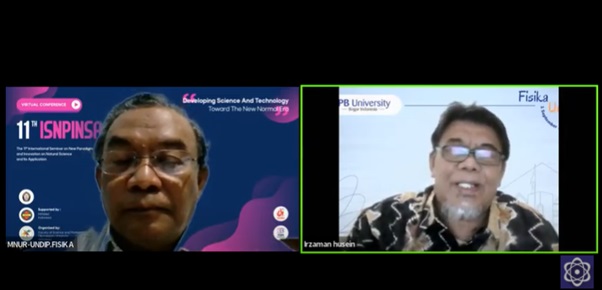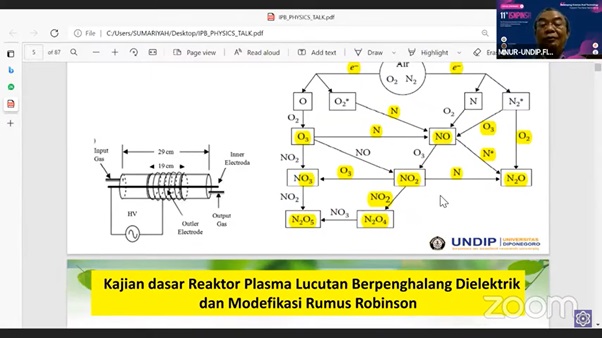
The Department of Physics of IPB Presents Plasma Technology Experts, Discussing From Theory to Commercial Products.
The Department of Physics of IPB Presents Plasma Technology Experts, Discussing From Theory to Commercial Products.
Thursday (24/2/22), the Physics Department of FMIPA IPB University through the 24th edition of the Physics Talk activity again presented researchers, experts and practitioners in various fields of physics. This time, a plasma technology expert from the Center for Plasma Research at Diponegoro University, namely Prof. Dr. Muhammad Nur, DEA is present online. Prof. M. Nur presented material entitled “Science and Plasma Technology from the Laboratory to Become an Innovation Product for the People and Increase the Nation’s Competitiveness.”
The research conducted at the Center for Plasma Research is cold plasma research. Plasma itself is simply a gas that is ionized at high temperatures and is capable of flowing electric charges, with lightning as a real example in nature. As the fourth state of matter after solid, liquid, and gas, plasma has different thermodynamic laws from other states of matter, and has many applications.
Prof. M. Nur said that cold plasma produces various plasma species, namely ions, electrons, radicals, excited atoms and molecules, photons, and UV radiation. Air plasma (atmospheric plasma) through a “plasma gun” which is an accelerated electron shot can produce Reactive Oxygen Species (ROS) and Reactive Nitrogen Species (RNS), which are useful in various fields. The ROS and RNS produced include superoxide (O2⋅), hydroxyl (⋅OH), peroxyl (RO2⋅), alkoxyl (RO), hypochlorous acid (HOCl), ozone (O3), singlet oxygen (1O2), hydrogen peroxide ( H2O2), nitric oxide (NO.), peroxynitrite (ONOO.), and nitrogen dioxide (NO2).

Prof. M. Nur recounted the team’s journey for two decades in developing a plasma reactor based on Dielectrics Barrier Discharge (DBD). The theoretical basis used is the modified Robinson formula (1961) so that a DBD-plasma reactor with a multi-dielectric system can be produced. DBD technology continues to be developed into Double Dielectrics Barrier Discharge DBD and used as an Ozone generator.
On the other hand, mastery of scientific aspects for invention and innovation alone is not enough to increase national independence. There is a wide gap between innovation and economic and social development. This gap is a “valley of death” because most scientists in Indonesia only work on research and innovation, perhaps on a laboratory scale, but cannot develop their inventions and innovations for commercial use. This is where collaboration between universities and companies is needed to develop a final product that is ready for market.
The superior product produced by the Center for Plasma Research is the implementation of cold plasma products for indoor air cleanliness. This product is trademarked “Zeta Green”. This product can reduce the transmission rate of bacteria, viruses and fungi, as well as reduce bad odors, cigarette smoke and other pollution. It is undeniable that the need for products has increased due to the Covid-19 pandemic. The test results showed that Zeta Green could inhibit the SARS-CoV-2-2ml virus by up to 100% for 1 hour. Cold plasma can kill viruses and bacteria because plasma-emitting ROS and RNS can generally damage chemical bonds in cell walls, perforate cell membranes, cause peroxidation of membrane lipids, reduce cell replication, damage DNA and RNA, denature proteins, and lose enzyme activity. .
In agriculture and horticulture, products are produced in the form of post-harvest horticultural product storage devices using ozone technology. Apart from the tool itself, Prof. M. Nur is also the drafter of the SNI design for the quality requirements and method of testing this technology. Ozone plasma technology in the processing of horticultural products consists of 7 standard steps, which if properly applied can reduce post-harvest product waste by up to 3% in chili peppers.
A product that is still under development is an ozone generator for medical applications. One of them is to heal wounds faster.
In the question and answer session, Prof. M. Nur also conveyed the application of plasma in cleaning waste, for example batik cloth washing water. With nanobubble technology, ozone is injected into the wastewater and the dye is separated from the washing water so that it can be disposed of safely into the environment.
The conclusion was delivered by the moderator, Dr. Irzaman about the importance of upstream to downstream research to increase national independence, and cooperation so that commercial products can be produced.
The activity was closed by the Head of Applied Physics Division, Dr. Irmansyah and Head of the Physics Department of IPB Prof. Tony Ibnu Sumaryada. Dr. Irmansyah stressed that apart from being involved in science, a researcher can also build works in the community, especially improving the welfare of farmers. (rfa)



